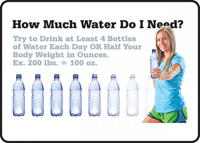



Find all of your laboratory and workplace safety supplies at Safety Emporium!
 EINECS |
 Glossary Index |
 Embolism |
| MSDS Topics |
Free Sites | FAQ's | Regulations | Glossary | Software | Suppliers |
| Books | Forum | Poll | Fun stuff | Quiz | Store | |
| Understand your MSDS with the MS-Demystifier | Search ALL our MSDS info | |||||
An electrolyte is a substance that, when dissolved in water, gives a solution that can conduct electricity. In your body, these are most often dissolved salts that contain sodium and potassium ions. Electrolytes are also called ionic solutes.
The concentration of dissolved salts (electrolytes) in your blood affects all of your bodily functions. For example, sodium and potassium ions are vital to the central nervous system, but too much (or too little) of either can kill you.
Having the wrong concentration or ratio of electrolytes can lead to fatigue, light-headedness, collapse and death among other nasty things.
When the electrolyte concentration of your blood is higher than that inside your cells, we call this a hypertonic state. Through a process called osmosis, water leaves your cells, making them contract and distort (crenation). Eventually, they cease to function.
When the electrolyte concentration of your blood is lower than that inside your cells, we call this a hypotonic state. Water enters your cells, and they swell until they burst and die (lysis).
For these reasons, intravenous (I.V.) solutions and injections typically use water that has the same electrolyte concentration as human blood (an isotonic solution) rather than pure water. When a patient's electrolytes are out of balance then administration of hypotonic fluids or diuretics may be required.
Electrolytes usually appear on a Safety Data Sheet in one of two contexts either on Section 11 (toxicological information) as a symptom of exposure or Section 4 (first-aid measures).
Exposure to or ingestion of certain chemicals such as diuretics may affect the electrolyte balance of the body. Likewise, dehydration or prostation from working in hot environments can creat a hypertonic state. Electrolyte imbalance can be a life-threatening condition if not immediately treated.

Help your workers beat dehydration with heat stress prevention signs from Safety Emporium.
Additional definitions from Google and OneLook.
Entry last updated: Sunday, July 24, 2022. This page is copyright 2000-2025 by ILPI. Unauthorized duplication or posting on other web sites is expressly prohibited. Send suggestions, comments, and new entry desires (include the URL if applicable) to us by email.
Disclaimer: The information contained herein is believed to be true and accurate, however ILPI makes no guarantees concerning the veracity of any statement. Use of any information on this page is at the reader's own risk. ILPI strongly encourages the reader to consult the appropriate local, state and federal agencies concerning the matters discussed herein.